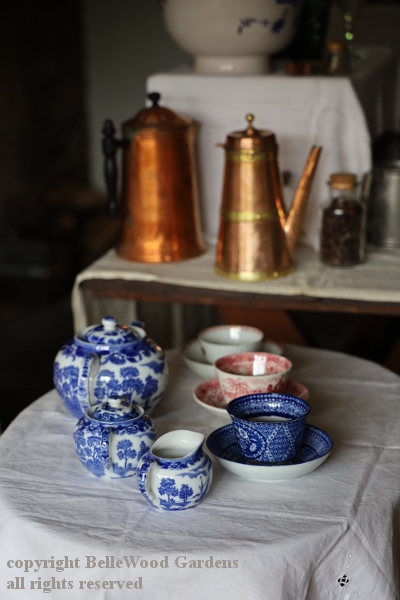
.
If you have any comments, observations, or questions about what you read here, remember you can always Contact Me
All content included on this site such as text, graphics and images is protected by U.S and international copyright law.
The compilation of all content on this site is the exclusive property of the site copyright holder.
Beer, Tea and Todies at the Bouman Stickney Farmstead Museum
Sunday, 8 September 2019
These days we take potable water for granted. But what could you drink if you cannot drink the water? Boil it, or brew it were the common answers back in the 17th and 18th century. And that's the focus of today's programs at the Bouman Stickney Farmstead Museum in Readington Township, New Jersey. Bev Altrath and Arlene Soong will again be back in the Dutch colonial kitchen, talking about tea and toddies, rum punch, shrubs, switchels, and George Washington's favorite, cherry bounce. At the same time, outdoors, historic brewer Rich Wagner will share, step by step, the techniques for making beer. Smaller scale than even a micro-brewery, it was something that was done at home.
What all of these beverages have in common are either boiling water, making it safe to drink, or adding alcohol or vinegar, which also reduce issues caused by microorganisms.

A lovely blue and white tea service, featuring tea pot, sugar bowl, and milk jug, and two handless teacups from the 18th and 19th centuries, 1790 and mid 1800's. Note that there are no handles, and rather than a flat saucer as we would see today, the tea bowl has a shallow bowl in which it sits. The tea bowl has a shallow bottom rim or foot, which will not get as hot as the thin wall when filled with tea. Behind the tea service are a copper coffee pot, and a copper pot for hot chocolate. The latter has an offset handle, which makes it much easier to see where you are pouring and when the cup is suitably filled.

There is a delicate, 17th century tea bowl in remarkably
excellent condition for something made 500 years ago.
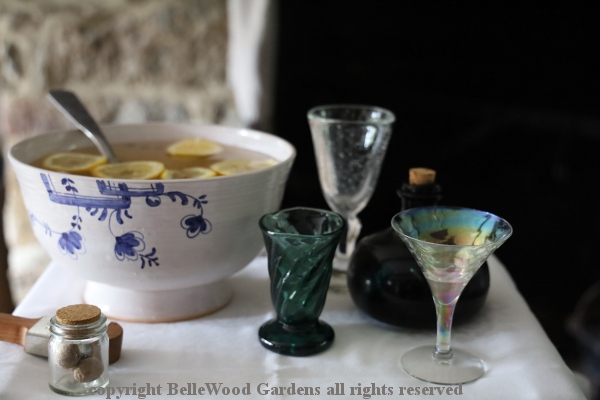
Rum punch. The word punch may be a loanword from Hindi, meaning "five," as the drink was frequently made with five ingredients: alcohol, sugar, lemon, water, and tea or spices. Rum was commonly available, lemons and limes were less so but were available, while oranges would have been the bitter, Seville orange, type.
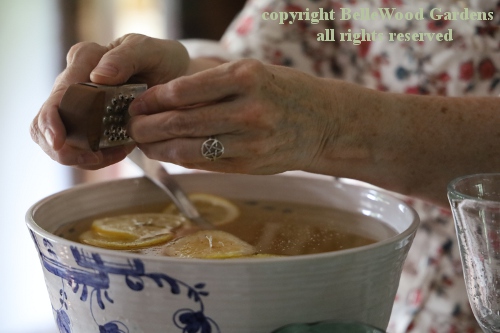
Bev Altrath is grating nutmeg into the very tasty rum punch. A recipe for Barbados
rum punch from the seventeenth century has a rather simple mnemonic: one of sour,
two of sweet, three of strong, and four of weak. Lime juice, sugar, rum, and water.
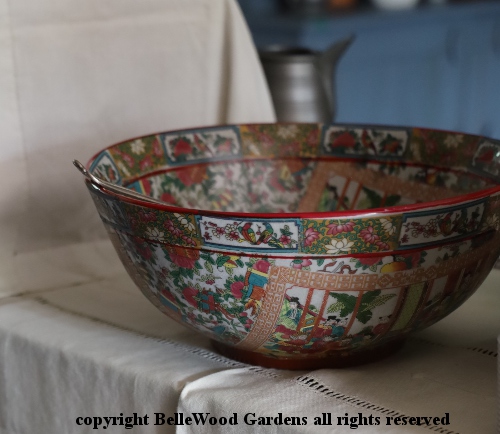
The ladies also have a beautiful chinoiserie punch bowl on display. Not in use though,
as there might be lead in the glaze. Besides, empty I can better appreciate its beauty.
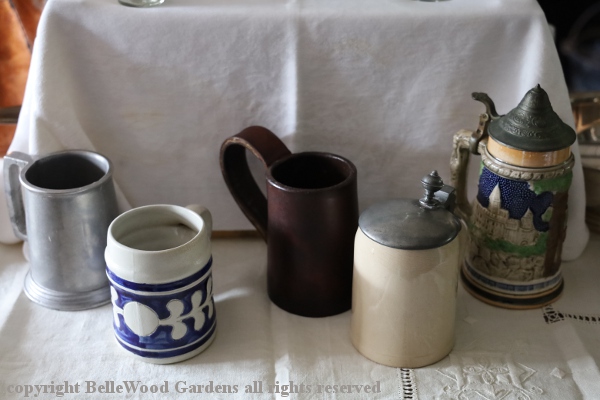
An assortment of mugs and tankards. The difference? Tankards have lids while
mugs do not. Plain, ornamented, pewter, pottery. Now pause for a moment and
think about the taken-for-granted coffee mugs cluttering up our kitchens today.

A charming owl headed pitcher - the head comes off and turns over
to become a cup. Enough strong drink and one indeed is overturned.

The deep windowsill is lined with bottles of various drinks. Shrub, made from fruit, sugar and vinegar. Switchel, aka haymaker's punch, made of water mixed with vinegar, ginger, and usually sweetened with molasses. Hard work out in the hayfield in late summer, the molasses helps replace electrolytes lost through sweating. Cherry bounce is very simple - Martha Washington probably used a crock to prepare this for George, but today you could use a very large glass jar. Cherries, lump sugar, and alcohol of choice - rum back then, today maybe vodka. Combine, let sit for a couple of months, then strain. Cherries, by now infused with alcohol, are a byproduct to serve over ice cream or pound cake.

Queried by a curious attendee, Bev described her gown with its gathers, a soft, padded bustle, her under gown or shift with its slightly longer than elbow length sleeves ending in a graceful ruffle, stays, and petticoat. She even lifted the skirt of her gown to show us her embroidered pockets, worn under the petticoat and accessible thru the side slits in the petticoat. No zippers, the front of her bodice is held closed with pins, and a pleated tucker stitched around the neck of the gown is another finishing touch. And of course her hair is neatly covered with a mob cap, fitted with a honey colored ribbon. Curious, I asked how much fabric is required. For the outer garment, five to six yards. But she tends to buy some extra.

During a lull in the presentation (as people arrive, come and go, join the outdoor beer brewing demonstration, come to the kitchen) Arlene takes a moment to sit and reads one of the recipe books that are available for visitors to peruse. She is wearing a shortgown, a working garment.
The beer brewing presentation in on-going outdoors, and that's where I head next.
First, understand that beers typically have from3% to 13% ABV, alcohol by volume. Beer was the common, daily, every day drink, even for children. They were given small or table beer, lower in alcohol, with an ABV of .5% to 2.8%. Even several tankards of small beer consumed at a sitting would be unlikely to cause intoxication.. It would also be what servants consumed, and likely was also what was served with meals. It kept you hydrated when working hard, and water was unsafe to drink.
Rich Wagner knows his beer. He loves beer making. He loves talking about brewing, its history, the ingredients, the equipment. With a range of casks, the smallest draped with a garland of hops, he's off and on his way. Today's ingredients are water, barley, hops. And yeast.
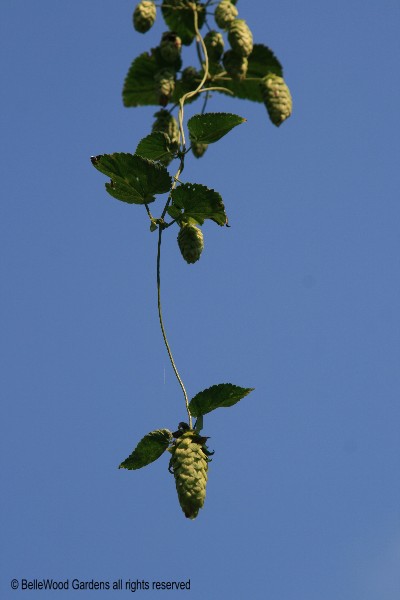
Here's a portion of a hop vine. The plants grow 10 feet or more each season.
Very aromatic. When my son was having a hectic time at work I made him a
small hops and lavender sachet to slip into the pillowcase. Restful, soporific.

The historical size of a traditional beer keg would have been 36 gallons. The next
size down would be half of that, while a quarter barrel or pony keg was half again,
or about 8 gallons. Kegs were wooden, made by a cooper, and an important item.

The barley is soaked for 3 days, then dried before being malted, that is, crushed but not ground. It is in pieces but the hull remains. Water is added and heated in the mash tun. The wort thickens into a somewhat porridge-like mass.
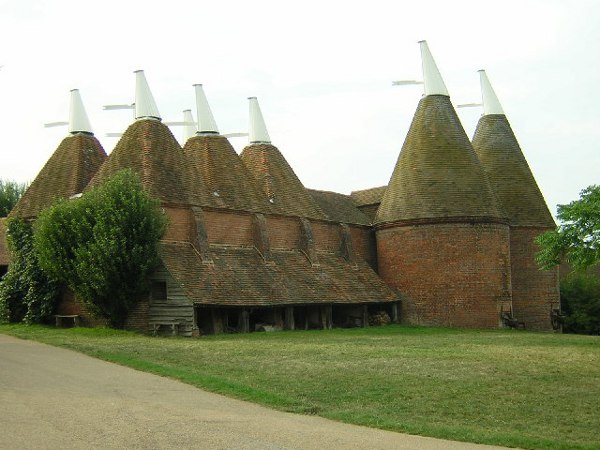
Wiki Commons, Creative Commons Attribution Share-alike license 2.0
As an aside, when in England and visiting Sissinghurst Castle and its renown gardens in Kent, I was fascinated with the oast houses to be seen in the countryside. Used for drying hops, the brick buildings have a steep pitched roof to channel hot air from the drying floor through the green hops. Technically, I believe, beer brewed without hops is known as ale. But that distinction has become rather vague.

Beer brewing has a language all its own, with technical terms such as lautering and sparging. If I understand this - and I'm sure someone will correct me if I'm wrong - it is basically pouring off the liquid and leaving the solids behind. Mistress Wagner is dipping out of the mash tun and pouring the liquids through a layer of hops into the tray. The tray has a wooden stopper in the front corner. When it is pulled out, the cooling liquid will run into the tub below. Today is really too warm to be brewing. Rich wants temperatures of 40 to 50 degrees or so, to allow the wort to cool and yeast to be added. He's demonstrating the process for us, but this will not eventually become beer, alas.
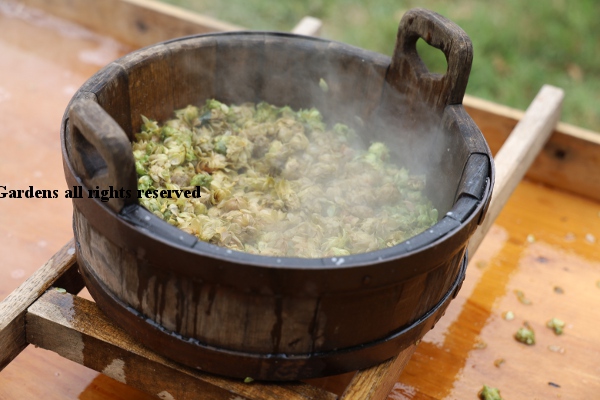
This is not the only time the hops and wort come together. Heating hops with the wort
adds bitterness, pouring wort through the hops adds flavor from the resin on the cones.
Rich grows his own Cascade hops, a 20th century hybrid cultivar developed in Oregon.
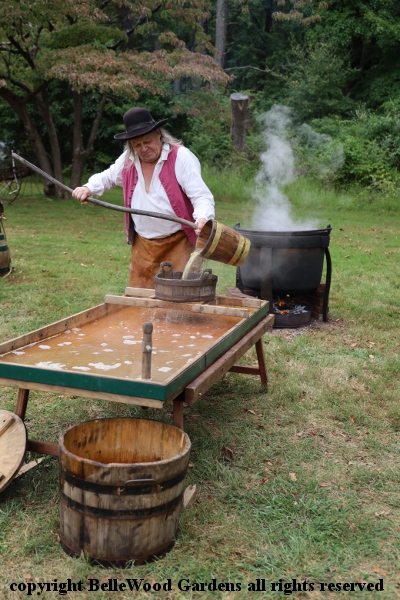
Notice the long handle on his bailer. Rich had the cooper search for a piece of cherry that had a branch reaching out. It was shaped into a stave, the branch became the integral, exceptionally strong handle, suitable for safely lifting and pouring hot liquids.
What an informative day at Bouman Stickney Farmstead Museum.
But then, they always are. Enjoyable too.
Back to Top
Back to September 2019
Back to the main Diary Page